All are welcome to attend our next Melodrama Meeting which will take place on the 8th of December, Jarman 7, 5-7pm. We will be discussing in depth the group’s work with the Melodrama Research Consortium. Definitions of melodrama, especially in theatre and film, will be a key focus.
Tag Archives: Definition of melodrama
Summary of Discussion on In This Our Life
Our discussion on John Huston’s film 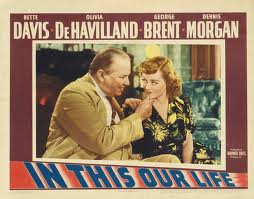 noted its focus on family. Sisters Stanley (Bette Davis) and Roy’s (Olivia de Havilland) lives are closely intertwined, partly as the former steals the latter’s husband (Dennis Morgan). In addition, the women’s father previously co-owned a business now run by their invalid mother’s (Billie Burke) brother (Charles Coburn). This is further complicated by the suspiciously close, and highly disturbing, relationship between Stanley and her uncle. Such interconnectedness comments on the American Film Institute’s (AFI’s) definition of melodrama, which notes family as an important aspect: The AFI defines melodramas as ‘fictional films that revolve around suffering protagonists victimized by situations or events related to social distinctions, family and/or sexuality, emphasizing emotion’. (http://afi.chadwyck.com/about/genre.htm)
noted its focus on family. Sisters Stanley (Bette Davis) and Roy’s (Olivia de Havilland) lives are closely intertwined, partly as the former steals the latter’s husband (Dennis Morgan). In addition, the women’s father previously co-owned a business now run by their invalid mother’s (Billie Burke) brother (Charles Coburn). This is further complicated by the suspiciously close, and highly disturbing, relationship between Stanley and her uncle. Such interconnectedness comments on the American Film Institute’s (AFI’s) definition of melodrama, which notes family as an important aspect: The AFI defines melodramas as ‘fictional films that revolve around suffering protagonists victimized by situations or events related to social distinctions, family and/or sexuality, emphasizing emotion’. (http://afi.chadwyck.com/about/genre.htm)
 Family is further emphasised were by the constant contrasting of Stanley and Roy. This was done on several levels. Personality and behaviour are of course key, but costume also plays a significant role. While Olivia de Havilland is introduced wearing a muted blue outfit (her father helpfully comments on the colour of the dress suiting her since the film is shot in black and white) Stanley is often seen in flashier outfits of prints, plaid patterns and flouncy frills. Furthermore she is criticised by other members of her family for wearing skirts which are too short.
Family is further emphasised were by the constant contrasting of Stanley and Roy. This was done on several levels. Personality and behaviour are of course key, but costume also plays a significant role. While Olivia de Havilland is introduced wearing a muted blue outfit (her father helpfully comments on the colour of the dress suiting her since the film is shot in black and white) Stanley is often seen in flashier outfits of prints, plaid patterns and flouncy frills. Furthermore she is criticised by other members of her family for wearing skirts which are too short.
Stanley and Roy’s reactions to tragedy also tellingly involve clothes. After learning that her husband has deserted her for her sister Stanley, Roy angrily asserts that ‘I’m not wearing black’ and resolves to buy a red hat with a feather. We see her wearing the accessory soon after, but the film’s black and white photography downplays the colour’s vividness. Similarly, when Stanley is supposedly heartbroken after the suicide of her husband she soon casts aside black outfits. Instead she opts for a light plaid which shocks her bed-ridden mother. The reactions of both sisters therefore involve the dismissal of black costumes. However, differences in the degree of seriousness of the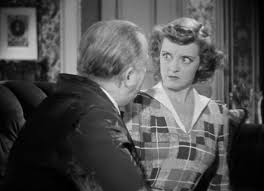 situations they are responding to is significant. While both have lost a husband (the same husband) Stanley has driven Peter to suicide. Also while Roy speaks of behaving badly to get what she wants (as Stanley always does) she does not follow though on this. Instead she does what the narrative expects – she falls in love with Stanley’s discarded fiancé, Craig (George Brent).
situations they are responding to is significant. While both have lost a husband (the same husband) Stanley has driven Peter to suicide. Also while Roy speaks of behaving badly to get what she wants (as Stanley always does) she does not follow though on this. Instead she does what the narrative expects – she falls in love with Stanley’s discarded fiancé, Craig (George Brent).
De Havilland and Davis’ acting was also markedly different. While de Havilland was not necessarily always restrained, her main outburst is the one outlined above. By contrast Davis is constantly playing at fever pitch. Davis’ performance involved variation in terms of embodying coyness, girlishness (very much denoted by Davis’ higher than usual voice), anger, seduction, deviousness etc, but there were very few, if any, moments were Davis/Stanley was completely still. Even when Davis/Stanley is sat listening to a gramophone record she is performing a dance with her shoes. It is also very noticeable that Davis’ face is never at rest. We particularly commented on Davis’ use of her eyes.
We also related Davis’s performance to her precious incarnation of Mildred in Of Human Bondage (1934, John Cromwell). (You can see our earlier discussion of this film here: http://blogs.kent.ac.uk/melodramaresearchgroup/2013/10/10/summary-of-discussion-on-of-human-bondage/) Stanley and Mildred are both irredeemable characters, devoid of any moral compass. The impact of Stanley’s selfishness is more far-reaching however. While in Of Human Bondage the main person who suffered was the film’s protagonist, Philip, in In This Our Life Stanley devastates Roy and Craig, other members of her family and significantly a young employee of colour, Parry Clay (Ernest 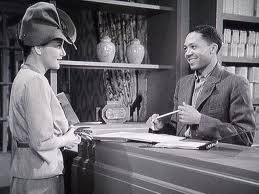 Anderson), who Stanley blames for a fatal car accident she caused while drunk. This is shown in opposition to Roy and Craig’s kind treatment of Parry. Roy works with Parry at an Interior Decorators and she finds him work at Craig’s law office (Craig is a Civil Rights lawyer) when Parry expresses his wish to train as a lawyer.
Anderson), who Stanley blames for a fatal car accident she caused while drunk. This is shown in opposition to Roy and Craig’s kind treatment of Parry. Roy works with Parry at an Interior Decorators and she finds him work at Craig’s law office (Craig is a Civil Rights lawyer) when Parry expresses his wish to train as a lawyer.
Max Steiner’s score was also discussed. This accompanies many of the film’s emotional moments and is also used to foreshadow bad news. During several telephone calls when we are only privy to one side of the conversation the film’s music heavily underscores a sense of impending doom also conveyed by dialogue and actors’ expressions.
Do, as ever, log in to comment, or email me on sp458@kent.ac.uk to add your thoughts.
Summary of Discussion on Coquette
Posted by Sarah
The discussion prompted by Coquette focused on several areas: the definition of melodrama, especially in relation to content vs form; the film’s old-fashioned feel; comparison of Norma’s punishment to other female characters at the time and earlier; Mary Pickford’s star entrance; Pickford’s star image – from the Girl with the Curls to the Woman Without Them; Hollywood’s focus on youth; modern actresses and image changes; Pickford’s performance.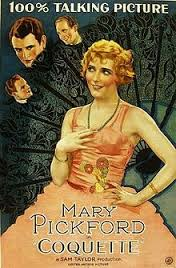
We began by relating the film to our previous experience of, and assumptions about, melodrama. The basic story has many melodramatic elements. The central character is a young woman named Norma (played by Mary Pickford) whose reputation is at stake. A misunderstanding leads to Norma’s lover Michael (played by Johnny Mack Brown) being shot by her father and a death-bed scene. This results in a murder trial where Norma attempts to save her father’s life by perjuring herself. She tries to convince the court that Michael raped her, therefore providing her father with a reason for his action.
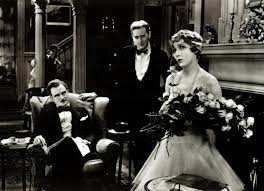 However the storytelling is not very melodramatic. The film did not follow the theme of concealment and revelation we have noted in other melodramas. A key example of this is the fact that Norma told her brother, and the audience, of her intention to lie on the witness stand. This meant we were not left in suspense as to how she might react. In addition, while Norma and Michael’s separation is presumably meant to be very distressing to both of them, the film does not convey this strongly. We also thought that Norma’s long-standing, and older, admirer Stanley (Matt Moore) might have played a larger part in the film, providing the third point of a melodramatic triangle. This was not the case.
However the storytelling is not very melodramatic. The film did not follow the theme of concealment and revelation we have noted in other melodramas. A key example of this is the fact that Norma told her brother, and the audience, of her intention to lie on the witness stand. This meant we were not left in suspense as to how she might react. In addition, while Norma and Michael’s separation is presumably meant to be very distressing to both of them, the film does not convey this strongly. We also thought that Norma’s long-standing, and older, admirer Stanley (Matt Moore) might have played a larger part in the film, providing the third point of a melodramatic triangle. This was not the case.
The difference between the film’s content and its form (primarily its plotting–both overall and within scenes) is therefore important. Since the story has melodramatic elements but the plotting does not highlight this, might we consider the film to be intended as melodrama, but simply not very effective? Or does the lack of suspense in terms of concealment and revelation preclude us from considering it to be melodrama at all? Of course this assessment of ‘quality’ rests on our judgment today, and views at the time might well have been different.
Coquette was based on relatively recent (1927) play of the same name by George Abbot and Ann Preston Bridgers. The film’s contemporaneous (to its release) setting is foregrounded by long-held close-ups of invitations to dances in 1928. However, we thought the film seemed old-fashioned for its time. The ‘feel’ was compared to that of Pleasantville (1998) in which the two main characters from the 1990s find themselves inhabiting a chirpy 1950s America.
The film’s old-fashioned nature was especially seen in the treatment of the main character. Norma’s ‘sins’ are small. She has spent the night, unchaperoned, with the man she loves in a cabin. Nothing happened between them. Yet she is severely punished: her lover is shot dead; she feels compelled to paint a very negative view of his character in order to help her father be acquitted of a murder charge; she witnesses her father’s suicide at his trial.
character. Norma’s ‘sins’ are small. She has spent the night, unchaperoned, with the man she loves in a cabin. Nothing happened between them. Yet she is severely punished: her lover is shot dead; she feels compelled to paint a very negative view of his character in order to help her father be acquitted of a murder charge; she witnesses her father’s suicide at his trial.
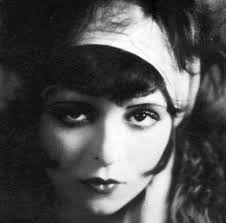 The New Woman was already well established in Hollywood films by this time. Colleen Moore played the definitive flapper in Flaming Youth six years earlier, and Clara Bow appeared to have It in 1927. Compared to these, and others, and especially given the fact that Norma’s sins are fairly insignificant – she is a coquette, or a flirt after all, not a ‘bad’ woman or a prostitute – the film seems out of its time.
The New Woman was already well established in Hollywood films by this time. Colleen Moore played the definitive flapper in Flaming Youth six years earlier, and Clara Bow appeared to have It in 1927. Compared to these, and others, and especially given the fact that Norma’s sins are fairly insignificant – she is a coquette, or a flirt after all, not a ‘bad’ woman or a prostitute – the film seems out of its time.
We connected this strongly to Mary Pickford’s star image. The film was presenting a ‘new’ Mary one who way ‘bobbed, audible and coquettish’ according to Photoplay in May 1929. We spoke at some length about Pickford’s star entrance. Norma is referred to, but not seen, for some time. Immediately before we see her she is being joshed by her brother Jimmy about spending too long in front of the mirror. We only hear her voice to begin with. This is frustrating on two counts – the quality of Pickford’s voice is less assured than those of the other actors (though there may also be some microphone issues) and our sight of her is delayed. When she does appear though, she is very striking. As well as the new hairstyle, Pickford is wearing a beautiful modern dress. While this is modest in some ways the flimsy material focuses attention on her legs.
not seen, for some time. Immediately before we see her she is being joshed by her brother Jimmy about spending too long in front of the mirror. We only hear her voice to begin with. This is frustrating on two counts – the quality of Pickford’s voice is less assured than those of the other actors (though there may also be some microphone issues) and our sight of her is delayed. When she does appear though, she is very striking. As well as the new hairstyle, Pickford is wearing a beautiful modern dress. While this is modest in some ways the flimsy material focuses attention on her legs.
The way youth was used to ‘sell’ stars and films was seen in the Photoplay piece and has been the subject of academic work. (See Heather Addison. “” Must the Players 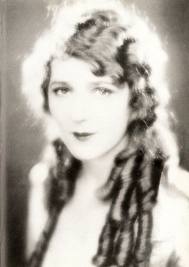 Keep Young?”: Early Hollywood’s Cult of Youth.” Cinema Journal 45.4 (2006): 3-25.) It was thought that this new image was not thoroughly modern as perhaps Pickford could not risk alienating her established fan base. Much of her previous appeal had been predicated upon recognition of her as ‘Little Mary’ or the ‘Girl with the Curls’. This relies on a very different presentation of youth. It is also at odds with the fact Pickford’s capability as a businesswoman (a co-founder of United Artists) and her private life – her happy marriage to Douglas Fairbanks – were continually dealt with in the press.
Keep Young?”: Early Hollywood’s Cult of Youth.” Cinema Journal 45.4 (2006): 3-25.) It was thought that this new image was not thoroughly modern as perhaps Pickford could not risk alienating her established fan base. Much of her previous appeal had been predicated upon recognition of her as ‘Little Mary’ or the ‘Girl with the Curls’. This relies on a very different presentation of youth. It is also at odds with the fact Pickford’s capability as a businesswoman (a co-founder of United Artists) and her private life – her happy marriage to Douglas Fairbanks – were continually dealt with in the press.
Gaylyn Studlar has written that Pickford appealed to the, in some ways already vanished, Victorian notion of childhood and its excessive sentimentality. (See Gaylyn Studlar, “Oh,” Doll Divine”: Mary Pickford, Masquerade, and the Pedophilic Gaze.” Camera Obscura 16.3 (2001): 196-227.) As Studlar pondered the audience for Pickford’s silent films we were also curious as to the intended and actual audience for Coquette. The appeal to the modern seen in Photoplay’s focus on consumption was severely compromised by the film itself. Although Pickford was indeed ‘bobbed, audible and coquettish’ she did not seem young: Norma/Pickford was not seen engaging in the frantic dancing of the other youths in the film. The moralistic tone of the play – there is no happy ending which is unusual for other melodramas of this, and an earlier, period – seemed unlikely to sit well with those who had seen It and Flaming Youth.
 We broadened out the discussion to some others of Pickford’s contemporaries. While Moore and Bow symbolised the new, Lillian Gish, like Pickford, was of the past. However Lillian Gish’s appeal, while also based on innocence, was not dependant on her occupying a child’s role. The playing of child roles seemed very particular to Pickford. Gish was far more often a child-woman. As early as 1920 she was playing single mother in Way Down East.
We broadened out the discussion to some others of Pickford’s contemporaries. While Moore and Bow symbolised the new, Lillian Gish, like Pickford, was of the past. However Lillian Gish’s appeal, while also based on innocence, was not dependant on her occupying a child’s role. The playing of child roles seemed very particular to Pickford. Gish was far more often a child-woman. As early as 1920 she was playing single mother in Way Down East.
Some modern actresses who have noticeably had a ‘statement’ haircut in order to break free from their earlier star images were also mentioned: Harry Potter’s Emma Watson and Miley ‘Hannah Montana’ Cyrus. We also cited several actresses who, like the 37 year-old Pickford in Coquette, have played, or continue to play, younger than their actual age. These included Alyson Hannigan, Charisma Carpenter and Natalie Portman.
 The change in Pickford’s hairstyle was clearly significant, yet the nod to the modern was not extended to the film’s treatment of her character’s morality and behaviour or indeed Pickford’s acting style. At times Norma seemed very young. She climbed onto the lap of the maid (Louise Beavers) to be comforted. Pickford’s acting was occasionally heavy handed. The moment Norma feels an excessive pain in her chest which she takes to correspond to Michael being shot was particularly memorable since Pickford clutches her chest with such violence. Norma was also, unsurprisingly, hysterical on learning of her lover’s death.
The change in Pickford’s hairstyle was clearly significant, yet the nod to the modern was not extended to the film’s treatment of her character’s morality and behaviour or indeed Pickford’s acting style. At times Norma seemed very young. She climbed onto the lap of the maid (Louise Beavers) to be comforted. Pickford’s acting was occasionally heavy handed. The moment Norma feels an excessive pain in her chest which she takes to correspond to Michael being shot was particularly memorable since Pickford clutches her chest with such violence. Norma was also, unsurprisingly, hysterical on learning of her lover’s death.
Instances of the overtly dramatic sat uncomfortably with some of the film’s, few, lighter moments. One of these seems to in itself be mocking, or at the very least drawing attention to, melodramatic performance. Michael reacts to one situation with a moody and long-held stare. Norma/Pickford waits a little while, and then looks to the audience. The gaze then turns back to Michael with Norma/Pickford seeming to wonder at how Michael has managed to keep the pose for so long. Pickford’s performance within a performance is referenced throughout by one of her repeated gestures. After saying the word ‘adorable’ (whether to her admirer Stanley or her lover Michael) she places  her finger to her lip in a coquettish way, prompting others to kiss her. It is noticeable that when Norma/Pickford utters the word ‘adorable’ for the last time in the film, it is not accompanied by the gesture. The events Norma has been through have perhaps finally broken her meaning that any coquettish behaviour would be out of place.
her finger to her lip in a coquettish way, prompting others to kiss her. It is noticeable that when Norma/Pickford utters the word ‘adorable’ for the last time in the film, it is not accompanied by the gesture. The events Norma has been through have perhaps finally broken her meaning that any coquettish behaviour would be out of place.
Many thanks to Tamar for suggesting a film which provoked so much discussion.
Do, as ever, log in to comment, or email me on sp458@kent.ac.uk to add your thoughts.
Melodrama Screening and Discussion, 9th October, Keynes Seminar Room 6, 4-7pm
Posted by Sarah
All are welcome to attend the first of this term’s screening and discussion sessions which will take place on the 9th of October in Keynes Seminar Room 6, from 4pm to 7pm.
We will be screening Ann-Marie’s choice: Of Human Bondage (1934, John Cromwell, 83 minutes)
- What are the components of a melodramatic performance?
- How much of an influence does performance have on establishing a genre?
- Or, perhaps, do stars carry a performance type that will affect the categorizing of a film?
- Davis admitted that her performance style was theatrical rather than realistic. Is it this style that we find in most melodramas?
- How does performance differ between radio and film? How does this affect melodrama? (Please see a forthcoming post on Bette Davis links for more information.)
Do join us if you can for the first of 3 films which focus on performance.
Summary of Discussion on Mulholland Drive
Posted by Sarah
Our post-film discussion covered several areas, including how melodrama functions in Mulholland Drive; the relationship between the melodrama and horror genres; David Lynch’s other films; and definitions of melodrama. Do log in to comment, or email me on sp458@kent.ac.uk to add your thoughts.
 We began the discussion by noting the ways in which Mulholland Drive (2001) was related to our understanding of melodrama. Broadly speaking, the fact the plot focused on love and domestic matters was thought to relate closely to the family focus present in many melodramas. At a more specific level, some of the aesthetics pointed to melodrama: especially the scene which places Betty (Naomi Watts) firmly within the domestic setting of the kitchen as she makes coffee at the huge sink. This had echoes of 1950s melodramas, especially as it externalised the internal states of characters. Other of the film’s settings, and the costumes, also harked back to earlier Hollywood.
We began the discussion by noting the ways in which Mulholland Drive (2001) was related to our understanding of melodrama. Broadly speaking, the fact the plot focused on love and domestic matters was thought to relate closely to the family focus present in many melodramas. At a more specific level, some of the aesthetics pointed to melodrama: especially the scene which places Betty (Naomi Watts) firmly within the domestic setting of the kitchen as she makes coffee at the huge sink. This had echoes of 1950s melodramas, especially as it externalised the internal states of characters. Other of the film’s settings, and the costumes, also harked back to earlier Hollywood.
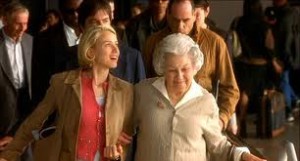 Indeed the film was a self-conscious meditation on melodrama, especially Hollywood melodrama. At times this slipped into parody or pastiche. Betty’s boundless joy at arriving in Los Angeles in particular seemed like a moment from a bad 1950s melodrama, or perhaps a ‘Visit Hollywood’ advertisement. The staging, dialogue and acting in the first part of the narrative was self-consciously
Indeed the film was a self-conscious meditation on melodrama, especially Hollywood melodrama. At times this slipped into parody or pastiche. Betty’s boundless joy at arriving in Los Angeles in particular seemed like a moment from a bad 1950s melodrama, or perhaps a ‘Visit Hollywood’ advertisement. The staging, dialogue and acting in the first part of the narrative was self-consciously  unconvincing, especially when involving Betty. There was praise for Watts’ performance(s), however. The switch from perky optimistic Betty to distressed Diane was very well-realised. Watts persuasively inhabited the role of suffering Diane in the second part of the film, making the character markedly different through the way she held herself and facial expressions.
unconvincing, especially when involving Betty. There was praise for Watts’ performance(s), however. The switch from perky optimistic Betty to distressed Diane was very well-realised. Watts persuasively inhabited the role of suffering Diane in the second part of the film, making the character markedly different through the way she held herself and facial expressions.
Other self-conscious aspects of the film drew attention even more strongly to the fact the film was constructed prior to our viewing of it. At Club Silencio the emcee informs Betty and Rita that the sound has been previously recorded, foregrounding the importance of illusion. It was also suggested that it is significant that this is the point just before the film’s narrative turns: that it is signposts the switch from melodrama parody to melodrama ‘proper’ as Diane is seen to be really suffering. Other instances in the film appear to downplay the melodrama though. The dramatic, if not melodramatic, fight scenes are undercut by slapstick comedy and black humour. We have previously noted that melodramas use humour, sometimes of minor characters, in order to provide 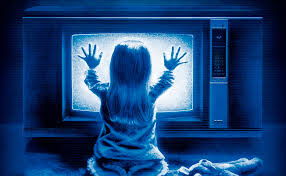 some relief from the melodrama (for example in both film versions of Gaslight), thereby heightening the melodramatic aspects. It is perhaps unusual to find the dramatic and comedic so closely entwined as in Mulholland Drive, though interestingly Poltergeist, another film with links to horror, employed this tactic.
some relief from the melodrama (for example in both film versions of Gaslight), thereby heightening the melodramatic aspects. It is perhaps unusual to find the dramatic and comedic so closely entwined as in Mulholland Drive, though interestingly Poltergeist, another film with links to horror, employed this tactic.
The importance of horror, its similarities to and differences from melodrama, was also raised. Both genres externalise the internal and Lynch’s particular combination of the two genres in Mulholland Drive – attaching the horror aesthetic to the melodramatic plot – was especially unsettling. Comparisons to Lynch’s Lost Highway (1997) were made. It  was noted that Cowboy (Monty Montgomery) in Mulholland Drive served a similar function to Mystery Man (Robert Blake) in Lost Highway. The importance of performance in these and other Lynch films – such as Eraserhead (1977) and Blue Velvet (1986) – was also noted. Despite similarities, Lost Highway was thought to be out-and-out horror, while Mulholland Drive’s use of melodrama complicates the matter. It was suggested that Lynch’s film express a modern melodrama, related to the Gothic, which is extreme.
was noted that Cowboy (Monty Montgomery) in Mulholland Drive served a similar function to Mystery Man (Robert Blake) in Lost Highway. The importance of performance in these and other Lynch films – such as Eraserhead (1977) and Blue Velvet (1986) – was also noted. Despite similarities, Lost Highway was thought to be out-and-out horror, while Mulholland Drive’s use of melodrama complicates the matter. It was suggested that Lynch’s film express a modern melodrama, related to the Gothic, which is extreme.
This led, once more, to debate on the definition of melodrama. A definition of melodrama has proved somewhat elusive – Martin Shingler and John Mercer define it as a ‘sensibility’ (in Melodrama: Genre, Style, Sensibility, 2004). We wondered if it would be useful to more fully appreciate the fact melodrama, like other genres, is not static. While other genres allow for subgenres to become more fully integrated into notion of what that genre is, this seems less true of melodrama. This is especially odd given the fact that our screenings have revealed the versatility of melodrama and its omnipresence. Indeed Linda Williams (in ‘Melodrama Revised’. Refiguring American Film Genres: History and Theory (1998) pp. 42-88) states that melodrama is the American art form. Meanwhile Hollywood arguably remains the dominant force in world cinema.
If we begin to take into account more subgenres of melodrama, and looser relations that exist between melodrama and other genres, this would open up new areas of discovery. It was suggested that it might be more profitable to talk of the melodramatic rather than melodrama. In addition, while it would be positive to not speak of melodrama in pejorative terms, this is in fact the way in which people use it, and changing this seems unlikely to happen. This comments effectively on how the Melodrama Research Group has engaged with the notion of melodrama: as it is, rather than how it should be, understood. Over the last few weeks the collision of melodrama and horror (Poltergeist and Mulholland Drive) has been especially useful in showing the long reach of melodrama.
Many thanks to Frances for selecting such a fantastic and fascinating film, and for kick-starting such fruitful discussion…
Summary of Discussion on Happy Together
Posted by Sarah
Our discussion extended into several different areas: Happy Together’s melodramatic elements; the importance of home and family to melodrama and to Happy Together; the Argentine setting; aspects of the film which negated the melodramatic elements; Wong Kar Wai; the articles by Kenneth Chan and Thomas Elsaesser; melodrama and excess vs restraint. As ever, do leave comments, or email me on sp458@kent.ac.uk to add your thoughts.
 We began by moving from the very general question we’ve often asked ‘What is melodrama?’ to ‘Is this particular film a melodrama?’ Some aspects of the film certainly fitted in with our understanding of melodrama: the suffering endured by ill-fated lovers Lai (Tony Leung) and Ho (Leslie Cheung) often expressed by tears; the exaggerated melodramatic gestures used by the actors when the couple lose their way (perhaps metaphorically as well as literally) on the road, as well as some of their other, more physical fights; the coincidences which occur throughout the film as Ho always manages to find Lai, and Lai runs into Chang’s family in Taipei.
We began by moving from the very general question we’ve often asked ‘What is melodrama?’ to ‘Is this particular film a melodrama?’ Some aspects of the film certainly fitted in with our understanding of melodrama: the suffering endured by ill-fated lovers Lai (Tony Leung) and Ho (Leslie Cheung) often expressed by tears; the exaggerated melodramatic gestures used by the actors when the couple lose their way (perhaps metaphorically as well as literally) on the road, as well as some of their other, more physical fights; the coincidences which occur throughout the film as Ho always manages to find Lai, and Lai runs into Chang’s family in Taipei.
Notions of home and the family were central to Happy Together. It was commented on that this was related to the family or domestic melodrama which Thomas Elsaesser focused on in his ‘Tales of Sound and Fury’ article. Home was less connected to Lai’s bedsit in which a fair amount of the film took place, than the fact the three main characters all wanted to leave Argentina to return to Hong Kong or Taiwan. This was  despite the fact that the culture of Argentina welcomed the main couple (the tango after all was first performed between male partners). It was thought important to consider that while the film must be contextualised within Chinese and Hong Kong melodrama (as Chan’s article does), the Argentine setting was also significant. However, it is true that the Hong Kong community had a strong presence in the film’s portrayal of Argentina. The focus on people rather than places was also seen in the assertion that family make home what it is. When Lai meets Chang’s family he says that he can see why Chang is happy to travel. At first this appears insulting, but he goes on to explain that this is because he has the security of his family to come back to. Conversely Lai’s father is disappointed in his son’s behaviour.
despite the fact that the culture of Argentina welcomed the main couple (the tango after all was first performed between male partners). It was thought important to consider that while the film must be contextualised within Chinese and Hong Kong melodrama (as Chan’s article does), the Argentine setting was also significant. However, it is true that the Hong Kong community had a strong presence in the film’s portrayal of Argentina. The focus on people rather than places was also seen in the assertion that family make home what it is. When Lai meets Chang’s family he says that he can see why Chang is happy to travel. At first this appears insulting, but he goes on to explain that this is because he has the security of his family to come back to. Conversely Lai’s father is disappointed in his son’s behaviour.
However, other elements of the film negate the melodramatic connections. Stylistically the film does not seem very emotional or melodramatic. The black and white cinematography which is used for much of the film denotes a documentary aesthetic. This associates the film more strongly with realism. The characters’ voice overs reinforce this as at times they help to explain the on screen action. The main voice over is Lai’s which in itself might link to melodrama and the fact this is his story. But the appearance of other voice overs skews this focus.
The melodrama is also downplayed by the cyclical nature of the narrative. The film restages similar situations (often focusing on strong emotions such as jealousy and passion) fairly regularly, but these also revolve around quite mundane situations. Little is ever resolved. Fights begin but do not always reach a dramatic climax, either because the other half of the couple does not wish to argue, storms out, or the film cuts away – sometimes to completely unrelated scenes. In addition, at times the film suggests connections through its editing, but these go nowhere. A lingering shot of Lai washing blood from the outside the abattoir he works at is juxtaposed with a scene of Ho scrubbing the bedsit floor and crying. It was thought at first by some that perhaps Ho  had killed Lai and this was the cause of his tears. Yet this was not followed up in the film. Happy Together’s cyclical pattern was compared to that of some of Douglas Sirk’s films, and the family/domestic melodrama more generally. In both Wai and Sirk’s films the characters are tragic figures who do not learn from their mistakes, though in Wai’s film the patterning is at a more narrative level. Indeed, this compulsion to ‘start over again’ is a key theme of Happy Together as Lai is always being persuaded to do just this by his on-off boyfriend.
had killed Lai and this was the cause of his tears. Yet this was not followed up in the film. Happy Together’s cyclical pattern was compared to that of some of Douglas Sirk’s films, and the family/domestic melodrama more generally. In both Wai and Sirk’s films the characters are tragic figures who do not learn from their mistakes, though in Wai’s film the patterning is at a more narrative level. Indeed, this compulsion to ‘start over again’ is a key theme of Happy Together as Lai is always being persuaded to do just this by his on-off boyfriend.
 This inability to resolve extends to the film’s ‘false ending’. At a point quite near to the actual ending of the film, Lai revisits the Falls which have played a key symbolic role in the film. Yet this is not the conclusion to the film: Lai then visits Taipei on his way home to Hong Kong, and Chang visits the lighthouse to try to lose Lai’s sadness. This happy ending seems added on and somewhat negates the melodramatic elements. It was also commented upon that the fact no one commits suicide at the lighthouse (which was initially how some of us interpreted it as a place for ‘leaving sadness behind’) makes it less melodramatic, as does the fact, unusually for a gay drama of the 1990s, none of the characters die.
This inability to resolve extends to the film’s ‘false ending’. At a point quite near to the actual ending of the film, Lai revisits the Falls which have played a key symbolic role in the film. Yet this is not the conclusion to the film: Lai then visits Taipei on his way home to Hong Kong, and Chang visits the lighthouse to try to lose Lai’s sadness. This happy ending seems added on and somewhat negates the melodramatic elements. It was also commented upon that the fact no one commits suicide at the lighthouse (which was initially how some of us interpreted it as a place for ‘leaving sadness behind’) makes it less melodramatic, as does the fact, unusually for a gay drama of the 1990s, none of the characters die.
It was also remarked upon that, as Kenneth Chan noted in his article, the film’s editing was particularly important. Indeed much of the film’s dramatic power originated in its editing as well as its subject matter. While the film’s pace was slow at times, at others it was very snappy – especially the speeded up scenes of public spaces which seemed unrelated to much of the ‘action’ and indeed to melodrama.
We also discussed Wong Kar Wai as an auteur. On a broad level, the notion of Hong Kong heritage and identity is clearly a main focus of his work. The symbolism of the Falls as an example of Wai’s wider concern with pathetic fallacy was more closely linked to melodrama, however. The ‘false ending’ intercuts scenes of Lai’s return to the Falls, his face saturated with spray, and those of Ho at the bedsit, crying. The symbolism was compared to similar instances in Wai’s works Chungking Express (1994) and In the Mood for Love (2000).

Comments were made on Elsaesser’s 1972 article. This relates to Wai due to the director’s status as an auteur and Elsaesser’s focus on auteurism. Elsaesser was clearly very influenced by Cahiers du Cinema and the examination of mise en scene for symbolism. In Happy Together this is mostly represented by the Falls. But while Elsaesser discusses a director’s other works, he does not address how an audience might have access to this information. Indeed his approach was thought to include much ‘reading-in’ from a critic or academic’s response rather than an audience’s.
Finally, contextualising Wai among other Asian directors was undertaken. Hirokazu Koreeda’s Nobody Knows (2004) downplays the inherent melodrama of a mother abandoning her children. We wondered if this restraint was therefore particularly true of Asian cinema. However it was also noted that directors from other National Cinemas such as Britain’s Ken Loach are also downbeat in their approach. We noticed that some of the films we’ve watched over the last 9 months have been melodramatic in plot as well as treatment (The Sheik, Gaslight) while others focus on suffering but are less obviously concerned with excess (Love on the Dole, Happy Together). This neatly comments on the infinite variety of melodrama, its treatment and its many meanings….
Many thanks to Keeley for choosing such an interesting film, which provoked a lot of useful discussion!

